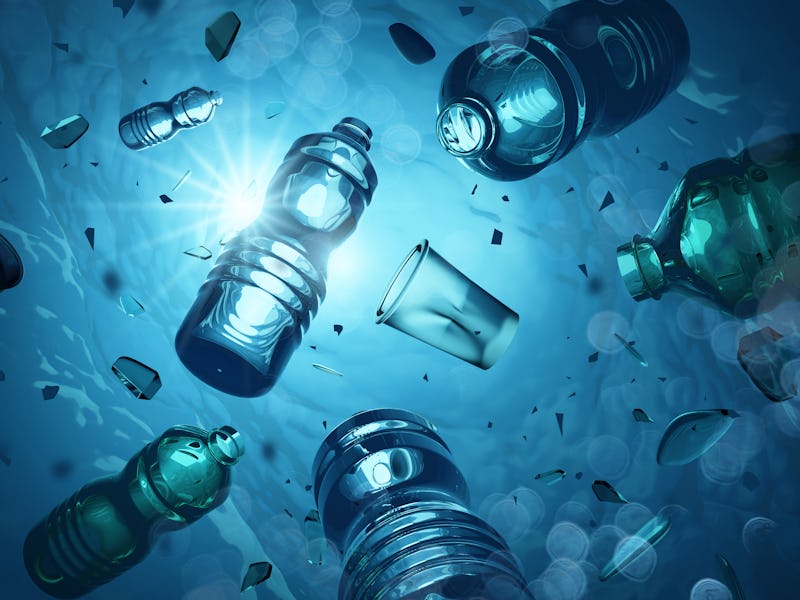Plastics have met their match in this bioinspired material
Say good-bye to plastic as you know it.

Plastic is everywhere — from our cellphones to sweaters and shoes. We depend on it.
It is an unhealthy addiction. Plastic is a danger to not only the environment, but also to animal and human health, too. But thanks to a team of Chinese nanochemists, we may soon be free. In a new study published Tuesday, they describe a bioinspired material that is not a mere replacement for plastic — it is better than plastic.
This material has more strength, toughness, and thermal stability than traditional plastic. Better yet, it is made using simple ingredients found in cosmetics and trees.
Shortly, this could be the thing that finally knocks plastic from its pedestal.
The problem with plastic has become impossible to ignore. Country-sized garbage patches clog oceans, while microplastic is swallowed by babies. Disentangling ourselves from this mess is easier said than done. After all, plastic is popular for a reason. It is easy to manufacture, it is tough enough to withstand vehicle crashes, and flexible enough to cling to other objects and protect them.
Finding a material with this mix of properties at a price cheap enough for mass production has long been a struggle. In their new study, published Tuesday in the journal Nature Communications, the researchers explain how past attempts to engineer a way out of our plastic problem have failed:
"Modern life relies closely on plastics, yet the vast majority of these plastics are derived from petrochemicals. [But] until now, sustainable structural materials constructed from bio-resources suffer from either limited mechanical properties or complex manufacturing processes, resulting in high cost and difficulty to produce in large scale."
The future of plastic could be based on one of nature's most elegant designs.
This time, the researchers took a different route. Instead of turning to chemistry to design a new super material to outshine plastic, the team instead turned to nature for inspiration. Specifically, a pearlescent material called nacre.
Nacre is mother-of-pearl. Aside from being beautifully iridescent, this material has a unique internal "brick-and-mortar" structure that gives it impressive natural strength and toughness, the researchers say.
See also: This strange biomaterial could be the basis of homes on Mars
Creating a plastic — To recreate nacre's structure and strength in a material to rival plastic, the researchers combined two other natural materials: cellulose and mica. Found in trees and rock, the team mixed the two materials together so that when pressed together, they formed an internal structure similar to that of nacre. The researchers called this method of squishing the materials together "direction deforming assembly"
In this case, the mica is the "bricks" and the cellulose is the "mortar."
Designing a better plastic is all in how you stack it.
They then compared the strength, toughness, and temperature stability of their new material to petroleum-derived plastic. The new material outperformed plastic across the board.
"Our biomimetic design of the highly ordered brick-and-mortar structure provides key ideas to fabricate sustainable structural materials for plastic replacement," the researcher say.
"We anticipate that this kind of all-natural bioinspired structural materials with excellent mechanical and thermal properties can play a key role in plastic replacement," they add.
The authors write that the natural raw materials used in this "plastic," as well as its simple assembly, mean there are few obstacles to scaling it up for manufacture. In the future, the researchers write this material can be used to design any number of essential and desirable products, including cell phones.
"Mass production, good processability, and tunable coloration allow it to be used to fabricate a series of advanced, beautiful, and durable structural materials to replace plastics, for example, structural support for high-end personal electronic devices."
More research and prototyping will be needed before this new material is ready to take on traditional plastics, but these results are an encouraging step forward.
Abstract: Petroleum-based plastics are useful but they pose a great threat to the environment and human health. It is highly desirable yet challenging to develop sustainable structural materials with excellent mechanical and thermal properties for plastic replacement. Here, inspired by nacre’s multiscale architecture, we report a simple and efficient so called “directional deforming assembly” method to manufacture high-performance structural materials with a unique combination of high strength (281 MPa), high toughness (11.5 MPa m1/2), high stiffness (20 GPa), low coefficient of thermal expansion (7 × 10−6 K−1) and good thermal stability. Based on all-natural raw materials (cellulose nanofiber and mica microplatelet), the bioinspired structural material possesses better mechanical and thermal properties than petroleum-based plastics, making it a high-performance and eco-friendly alternative structural material to substitute plastics.
This article was originally published on